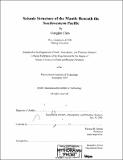| dc.contributor.advisor | Thomas H. Jordan. | en_US |
| dc.contributor.author | Chen, Liangjun, 1972- | en_US |
| dc.contributor.other | Massachusetts Institute of Technology. Dept. of Earth, Atmospheric, and Planetary Sciences. | en_US |
| dc.date.accessioned | 2010-09-03T18:28:14Z | |
| dc.date.available | 2010-09-03T18:28:14Z | |
| dc.date.copyright | 2001 | en_US |
| dc.date.issued | 2001 | en_US |
| dc.identifier.uri | http://hdl.handle.net/1721.1/58367 | |
| dc.description | Thesis (S.M.)--Massachusetts Institute of Technology, Dept. of Earth, Atmospheric, and Planetary Sciences, 2001. | en_US |
| dc.description | Includes bibliographical references (leaves 24-28). | en_US |
| dc.description.abstract | We jointly invert 1396 frequency-dependent travel times of turning and surface waves such as S, sS, SS, sSS, SSS, Sa, R1, and G1, together with 82 travel times of multiple ScS waves, to obtain a high-resolution, two-dimensional (2-D) vertical tomogram for the corridor between the Ryukyu subduction zone and Hawaii, which traverses the Hawaiian Swell between Midway and Oahu. The data analysis, inversion procedure, and parameterization are similar to our previous study along the Tonga-Hawaii corridor [Katzman et al., 1998], but in this study we add corrections to the measurements that account for the crustal heterogeneity and topography along the path. The model parameters include shear-speed variations throughout the mantle, perturbations to shearwave radial anisotropy in the uppermost mantle, and the topographies of the 410- and 660-km discontinuities. The model we obtained, which is well resolved in the upper mantle, exhibits high shear speeds at shallow depths and low speeds in the transition zone beneath the Pacific part of the corridor, with the lowest shear speed within a distinct upper-mantle anomaly at the depth of 200-400km near the Hawaiian Swell. Furthermore, we inverted the data from individual source arrays in New Hebrides, Solomon, and Mariana Island for two-dimensional vertical tomograms of mantle structure using the same technique as the Ryukyu-Hawaii corridor. The 2-D tomograms for these corridors were generally consistent with previous tomographic results, although they show uppermantle features that are smaller in scale and larger amplitude than published global models. We then inverted the entire data set from all corridors for a 3-D model of the southwestern Pacific upper mantle. At low wavenumbers, this regional model is consistent with large-scale features found from global tomography. However, our model displays greater lateral heterogeneity in both isotropic and anisotropic structure than the global models, especially in the 200-400 km depth range, which can be attributed to the better resolution of small-scale features by our data set. Fast and slow anomalies in isotropic shear speed are observed in the upper mantle, suggesting a complex 3-D mantle flow in the southwestern Pacific upper mantle. | en_US |
| dc.description.statementofresponsibility | by Liangjun Chen. | en_US |
| dc.format.extent | 42 leaves | en_US |
| dc.language.iso | eng | en_US |
| dc.publisher | Massachusetts Institute of Technology | en_US |
| dc.rights | M.I.T. theses are protected by
copyright. They may be viewed from this source for any purpose, but
reproduction or distribution in any format is prohibited without written
permission. See provided URL for inquiries about permission. | en_US |
| dc.rights.uri | http://dspace.mit.edu/handle/1721.1/7582 | en_US |
| dc.subject | Earth, Atmospheric, and Planetary Sciences. | en_US |
| dc.title | Seismic structure of the mantle beneath the southwestern Pacific | en_US |
| dc.type | Thesis | en_US |
| dc.description.degree | S.M. | en_US |
| dc.contributor.department | Massachusetts Institute of Technology. Department of Earth, Atmospheric, and Planetary Sciences | |
| dc.identifier.oclc | 50398858 | en_US |
